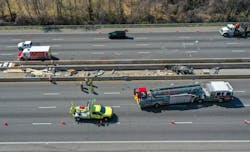Policy That Can Save Lives
By Paula Hammond, Contributing Author
Six roadway workers were killed on March 23 when a driver traveling at high speed collided with another car on Interstate 695 near Baltimore.
The force of the crash sent the vehicle barreling into a highway construction zone, causing it to flip. A video from a nearby Maryland Department of Transportation camera makes it clear no one in the pathway of that car had any chance to survive. The loss for the families is devastating and something that everyone in the transportation community also feels.
The names of the fallen should be remembered: Rolando Ruiz, 46; brothers Carlos Orlando Villatoro Escobar, 43, and Jose Armando Escobar, 52; Mahlon Simmons III, 31; Mahlon Simmons II, 52; and Sybil Lee Dimaggio, 46. The Simmons were a father and son.
As one victim’s widow told reporters, “Innocent people pay later for [motorists] mistakes.”
The five men and one woman were parents, brothers and a sister, uncles and an aunt, and in some cases, the sole provider for their family.
According to National Work Zone Safety Information Clearinghouse data, 857 people were killed in work zones in 2020—the most recent year for which data is available—because of mistakes by others.
One hundred percent of these incidents are preventable.
The 2021 Infrastructure Investment and Jobs Act (IIJA) law is delivering significant new federal resources to states for long overdue improvements to America’s transportation network. This means a proliferation in the number of construction zones, which in turn, means a much greater risk exposure for both highway workers and drivers.
This serious public health and safety issue takes on new urgency with another busy spring construction season getting underway.
While there is no replacement for alert and responsible driving, there are at least four policy-related actions state transportation agencies, elected officials, and the Federal Highway Administration (FWHA) could be initiating now to improve conditions for roadway construction workers:
Classifying Workers as Vulnerable Road Users: The IIJA requires FHWA to assist states in developing goals and programs aimed at protecting “vulnerable road users” or “VRUs,” such as pedestrians. Roadway workers are the epitome of “vulnerable” and federal and state agencies should work jointly to prioritize their safety to the same degree as other system users. This recognition is important as all states are required to complete an initial VRU Safety Assessment by November 15, 2023, and include it as part of their Strategic Highway Safety Plan.
Automated Speed Enforcement: When drivers know they will be ticketed for speeding, they will slow down. Illinois, Maryland, Pennsylvania, Michigan, Washington and New York have automated speed enforcement laws in place, and Indiana and Kentucky are working on approval. A study in Maryland showed an 80% reduction in speeding violations after automated speed enforcement began. Such laws should become more widespread. The IIJA allows states to use part of their federal funding to pay for such enforcement.
Positive Protective Measures: States can require increased use of barriers and other positive protection/separation between motorists and workers. In addition to traditional concrete barriers, steel, movable, and mobile barriers, greater use of truck-mounted attenuators (crash cushions) and portable rumble strips are all deployable options.
Work Zone Safety Contingency Funds: The IIJA allows state agencies to create contingency funds for additional protective measures for safety needs that are greater than anticipated when the contract was awarded. Creation of such funds would allow states and contractors to quickly add new measures to hazardous work sites, bypassing potential concerns raised when additional costs are added to a project.
By making such policy enhancements, transportation officials and policymakers at all levels can help reduce the number of work zone crashes to make certain that such a tragic loss of life like in Baltimore never happens again. R&B
Paula Hammond is a senior vice president with WSP USA and 2023 chair of the American Road & Transportation Builders Association (ARTBA).
